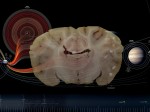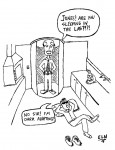By Erik, on February 8th, 2011 
Note inner circuitry, outer cortex.
Also note space, and travel-frequency inscriptions. Let us frequency inscribe the brain to space.
Visual cortex is the moon, frequently probed for its proximity to access. Temporal lobe is mars, origin of classic space aliens and epileptic hallucinations. Frontal cortices are nebulae, strange and shaping new forms. The amygdala . . . → Read More: Brains in Space
By Erik, on January 9th, 2011
By Erik, on November 23rd, 2010 Written for NYU Science Communication Workshop with Stephen Hall.
The Boy and the Paper
My science picked up over winter break of 2009. I was holed up on the top floor of a research building in a frozen Iowa City, night after night poring over data as a second year master’s student. I had collected . . . → Read More: The Boy and the Paper
By Erik, on November 19th, 2010 Check out the debut performance of the Space Clamps from this year’s Society for Neuroscience conference in San Diego, featuring Sara Steele on guitar, Emily Schulman on vocals, and yours truly on the keys:
. . . → Read More: Space Clamps!
By Erik, on November 9th, 2010 Kinetic perimetry maps the potential energy of activating the minimum number of photoisomerizations required for conscious detection. . . . → Read More: Visual Energy
By Erik, on November 8th, 2010 I wrote this Op-Ed piece for a Science Communication Workshop I’m in at NYU.
Science Fiction Turned Realities Gone Wild
Science fiction can often predict the future. Star Trek’s communicators foreshadowed the cell phone. 1984’s Big Brother exposed privacy concerns now relevant. We must take a look at the current science fiction world and ask . . . → Read More: Science Fiction Turned Realities Gone Wild
|
A sample text widget
Etiam pulvinar consectetur dolor sed malesuada. Ut convallis
euismod dolor nec pretium. Nunc ut tristique massa.
Nam sodales mi vitae dolor ullamcorper et vulputate enim accumsan.
Morbi orci magna, tincidunt vitae molestie nec, molestie at mi. Nulla nulla lorem,
suscipit in posuere in, interdum non magna.
|
|

